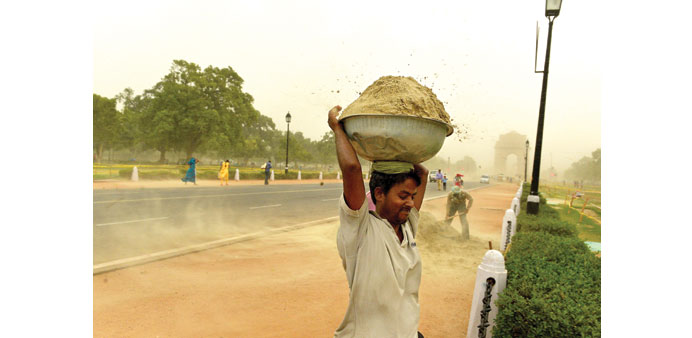An Indian labourer carries sand on his head during a dust storm in New Delhi yesterday. India’s capital was one of the states of India that experienced blistering heat earlier in May this year.
By Steff Gaulter
The monsoon has started to spread across India and for many of the people who live there, it’s not a moment too soon. The preceding heat was unbearable this year and led to the death of over 2,500 people. Now the rains have started, the heat has subsided, but the concerns about the weather have not, because the India Meteorological Department has issued a worrying forecast.
The month before the summer monsoon is always hot in India, it has to be. That’s because essentially the summer monsoon acts as the world’s largest sea breeze; it spreads across the region due to the difference in heating between the land and the sea.
The sun can heat land quicker than sea, which ensures that in the spring the huge Asian landmass heats up far more than the Indian Ocean. Hot air rises, so the air over the hot land lifts, and air from the sea rushes in to take its place. This replacement air has been sitting over the Indian Ocean for months and is laden with moisture. As it moves northwards over land, it brings heavy rain which sweeps across Sri Lanka then up through India and into Pakistan.
As you might imagine, this is rather a simplified explanation of the monsoon. If it were actually this straight forward, then forecasting it would be no problem! While there are many other factors which affect these rains, this description at least explains why May has to be such a hot month. The trouble is that this May was far hotter than usual. In many parts of India, the temperature was about 5C (7F) above average, but it was the high humidity that really caused the problems.
Living in Qatar, we know only too well that hot weather is made more unbearable if the humidity is high. That’s because the more humid the air is, the harder it is for our sweat to evaporate from our bodies, and therefore the harder it is for us to regulate our own temperature. I think we would all agree that the beginning of June was pretty hot and humid in Doha. One of the worst days was June 4, when the humidity peaked at 79%. On this day, the thermometer read 37C, but the moisture in the air ensured that it felt more like 46C. In India, the weather was even worse.
In Bhubaneswar, the capital of the eastern state of Odisha, the temperature climbed to 42C (108°F) on a day when the humidity reached 90%. The moisture in the air made the temperature feel more like 62C (144F). While we all try to imagine how horrific 62C would feel, it’s worth remembering that there isn’t the same wealth in India that there is in Qatar. Whereas almost all of us in Doha hide in air-conditioned boxes in summer (our homes, cars or offices), in India there are thousands and thousands of people who live in abject poverty. Trying to endure 62C without air conditioning just doesn’t bear thinking about.
Now the rains have started, the extreme heat has subsided in many locations, but there are still concerns about the weather. The monsoon rains are the lifeblood for millions of people across the region. For some parts of India, this will almost be the only rain that they see in the entire year. This is the time to plant crops and wait.
The amount of rain which falls during the monsoon is critical; every year the farmers are anxious to know when the rains will arrive and how much water they will bring. There are estimated to be as many as 600 million farmers across India and they know that there is a direct relation between their livelihoods and the strength of the rains.
Each year, the monsoon throws up some surprises, some of which are far more dramatic and devastating than others. In 2008, there was simply too much rain; crops and homes were washed away, and over 2,400 people lost their lives. Just one year later, in 2009, the opposite problem occurred when the rains failed, leading to shrivelled crops and soaring food prices. This year the forecast from the national meteorological department is that the monsoon will only deliver 88% of the average rainfall. Farmers are worried that this could lead to major problems.
The reason for the below-average forecast is our dreaded friend El Nino. El Nino is the slight warming of the surface water of the Pacific Ocean. It’s a natural phenomenon which happens every three to five years, and lasts for about eighteen months. The change is usually less than 1.5C, which sounds fairly insignificant, but it has a dramatic affect on the weather around the world. In India it has been noticed that El Nino often suppresses the monsoon rains.
The farmers will be hoping that this year’s monsoon forecast is wrong, after all there are many factors that effect the amount of rain that we don’t fully understand. However, as the rains continue to spread across India, all that can be done now is to watch and wait.

